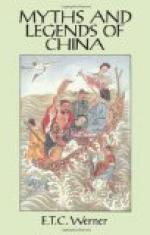The latter mourned by screaming, wailing, stamping their feet, and beating their breasts, renouncing (in the earliest times) even their clothes, dwelling, and belongings to the dead, removing to mourning-sheds of clay, fasting, or eating only rice gruel, sleeping on straw with a clod for a pillow, and speaking only on subjects of death and burial. Office and public duties were resigned, and marriage, music, and separation from the clan prohibited.
During the lapse of the long ages of monarchical rule funeral rites became more elaborate and magnificent, but, though less rigid and ceremonious since the institution of the Republic, they have retained their essential character down to the present day.
Funeral ceremonial was more exacting than that connected with most other observances, including those of marriage. Invitations or notifications were sent to friends, and after receipt of these fu, on the various days appointed therein, the guest was obliged to send presents, such as money, paper horses, slaves, etc., and go and join in the lamentations of the hired mourners and attend at the prayers recited by the priests. Funeral etiquette could not be pu’d, i.e. made good, if overlooked or neglected at the right time, as it could in the case of the marriage ceremonial.
Instead of symmetrical public graveyards, as in the West, the Chinese cemeteries belong to the family or clan of the deceased, and are generally beautiful and peaceful places planted with trees and surrounded by artistic walls enclosing the grave-mounds and monumental tablets. The cemeteries themselves are the metonyms of the villages, and the graves of the houses. In the north especially the grave is very often surmounted by a huge marble tortoise bearing the inscribed tablet, or what we call the gravestone, on its back. The tombs of the last two lines of emperors, the Ming and the Manchu, are magnificent structures, spread over enormous areas, and always artistically situated on hillsides facing natural or artificial lakes or seas. Contrary to the practice in Egypt, with the two exceptions above mentioned the conquering dynasties have always destroyed the tombs of their predecessors. But for this savage vandalism, China would probably possess the most magnificent assembly of imperial tombs in the world’s records.
Laws of Intercourse
Throughout the whole course of their existence as a social aggregate the Chinese have pushed ceremonial observances to an extreme limit. “Ceremonies,” says the Li chi, the great classic of ceremonial usages, “are the greatest of all things by which men live.” Ranks were distinguished by different headdresses, garments, badges, weapons, writing-tablets, number of attendants, carriages, horses, height of walls, etc. Daily as well as official life was regulated by minute observances. There were written codes embracing almost every attitude




